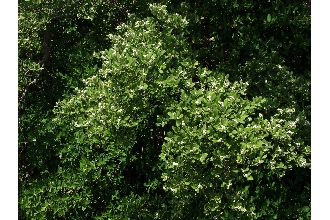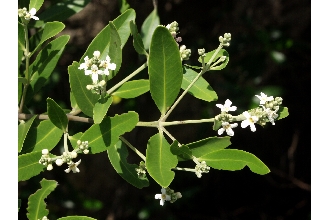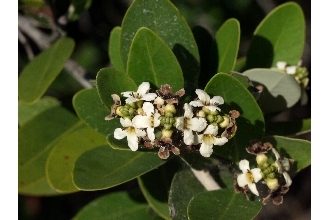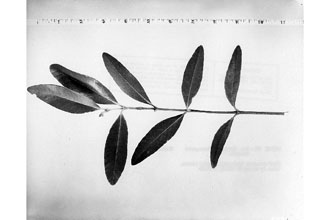Black Mangrove
Scientific Name: Avicennia germinans (L.) L.

| General Information | |
|---|---|
| Usda Symbol | AVGE |
| Group | Dicot |
| Life Cycle | Perennial |
| Growth Habits | ShrubTree, |
| Native Locations | AVGE |
Plant Guide
Alternate Names
None in common usage
Uses
Black mangrove is valuable in soil conservation in brackish and salt water marshes. It serves as nursery habitat for crustaceans and fish, and filters sediment for building new marsh. Black mangrove also mixes well with other native plants to reduce wave energy
Status
This species is native to the Gulf of Mexico and has not been identified as invasive or detrimental to the environment. Black mangrove is a native and valuable component of the marsh ecosystem. Please consult the PLANTS website and your State Department of Natural Resources for this plant’s current status (e.g. threatened or endangered species, state noxious status, and wetland indicator values)
Description
General: Black mangrove is a subtropical native woody shrub that grows in salt marshes. Mangroves are very hardy, having become adapted to harsh environments where water and salinity levels fluctuate. Pneumatophores, or breather roots, form a network, collecting silt and debris and controlling erosion. The pneumatophores are also excellent nursery areas for crustaceans in the marsh plant community. Height will vary from 4 to 9 feet. Leaves are 1 to 5 inches long, elliptical, opposite, thick, leathery, dark green, glabrous (smooth) above, and grayish with a tight felt-like pubescence beneath. Glands on the underside secrete salt. Clusters of small sessile flowers with white petals, approximately ½ inch in diameter, are borne in the leaf axils or growing tips on the twigs. The fruit are flat, approximately 1 inch long, dark green and glabrous beneath a velvety pericarp. The bark on the black mangrove is thick, dark brown or blackish, with rough irregular flattened scales. Twigs are grayish in color and smooth, with enlargements at the joints. Mangrove detritus (dead leaves and twigs) in water feeds microorganisms that provide food for young marine life. Distribution: For current distribution, please consult the Plant Profile page for this species on the PLANTS Web site. Habitat: Black mangrove grows in the intertidal zone throughout the Gulf of Mexico. Black mangrove is a truly unique plant species that, when established properly, and under applicable conditions, has provided land stabilization due to the easy transport of seedlings, quick aerial root production, Best practice has been to plant two to three year old seedlings because underground root systems increase sediment holding capabilities. This plant also provides for wildlife and marine habitats. (USDA/NRCS Plant Guide: Small, J.K 1933.)
Adaptation
Black Mangrove adaptation is in the sub-tropical to tropical Gulf of Mexico in intertidal zones. This plant is susceptible to freezing and the native range can be changed drastically by hard winters. The contributions of genetic diversity and habitat are presently under study to determine cold hardiness.
Establishment
Black mangrove establishes in nature from seed that floats and can travel some distance on the tides. Seed will germinate quickly to anchor young seedlings in good habitat. In the nursery, seed collected in the wild will not survive more than three to four weeks. Seed should be soaked in water, the pericarp removed and the seed planted in any commercial potting soil Germination normally occurs within a couple of weeks and seedlings take root. Recalcitrant seed on left, pericarp removed on right Garret Thomassie, USDA NRCS Golden Meadow PMC Our experience indicates that a normal variety of commercially available pots will suffice for germination and early growth. Plants can be maintained in fresh water tanks that hold moisture at the bottom of the pots.
Management
There are no data on managing native black mangrove stands. In the Gulf of Mexico the range of black mangrove is “managed” by the winter weather.
Pests and Potential Problems
There are no known pests that could threaten black mangrove stands in the wild, , Use soil moisture sensors to measure the soil moisture of Black Mangrove.
Environmental Concerns
Concerns
Concerns
Black mangrove has persisted in the intertidal marsh and is a valuable component of the ecosystem. Loss of black mangrove is a concern as it is a woody species that persists and assists in habitat development and in breaking wave energy and adds nesting habitat for birds including the pelican. Care must be taken to planting as black mangrove is very susceptible to freezing. More work needs to be done in collecting ecotypes that might be more frost resistant, or attention to habitat differences.
Seeds and Plant Production
Plant Production
Plant Production
Experience at the NRCS-Golden Meadow Plant Materials Center has shown that seed collected in the Fall (October to early December in South Louisiana) can be maintained for about a month, but should be planted as soon as possible after soaking removing the pericarp. There is work presently being conducted on maintaining seed for delayed germination, but at present, seed should have the pericarp removed and planted as soon as possible. Seed may be held longer with aeration (Personal communication Mat Benoit). Two year old seedlings or older (18 inches tall) seem to be best for successful out planting. Various sizes of tubes and pots have been used with success. The greater the root mass (not pot bound) the greater the chance of successful out planting. Planting where the tidal flow will cover and uncover the root collar is best. Soil types can vary from muck soils to areas that have some sand. Interior marsh planting Garret Thomassie, USDA NRCS Golden Meadow PMC New plantings in areas of high wave energy may have to be protected by baffles or anchoring the seedlings in place until the root system is capable of supporting the plant. Cultivars, Improved, and Selected Materials (and area of origin) The USDA NRCS Plant Materials Centers have released one variety: Pelican Germplasm black mangrove is a pre-varietal release from the Golden Meadow Plant Materials Center, Galliano, Louisiana, selected to provide a plant for soil conservation in brackish and salt water marshes. Contact your local Natural Resources
Conservation
Service office for more information. Look in the phone book under “United States Government”. The Natural Resources Conservation Service will be listed under the subheading “Department of Agriculture.”
Fact Sheet
Alternate Names
Avicennia nitida
Uses
Erosion control: Black mangrove is valuable in restoring brackish and salt water marshes due to its ability to filter and trap sediments. Mangrove forests, which include black mangrove, have a high capacity as a sink for excess nutrients and pollutants. It also mixes well with other native plants to reduce wave energy. Wildlife: Black mangrove serves as nursery habitat for crustaceans and fish. Mangrove detritus (dead leaves and twigs) in water feeds microorganisms that provide food for young marine life. It is estimated that as much as 80% of the organic budget of bays in Florida came from the surrounding mangrove forests. Black mangrove serves as nesting habitat for many coastal birds including brown pelicans.
Status
Please consult the PLANTS Web site and your State Department of Natural Resources for this plant’s current status (e.g. threatened or endangered species, state noxious status, and wetland indicator values).
Description and Adaptation
Adaptation
Adaptation
Black mangrove is a subtropical woody shrub that grows in salt marshes. Mangroves are very hardy and have become adapted to harsh environments where water and salinity levels fluctuate. Pneumatophores, or breather roots, form a network that collects silt and debris, and controls erosion. Pneumatophores are a major adaptation to the stresses of intertidal habitat. They allow root respiration in anaerobic, waterlogged soils. The pneumatophores are also excellent nursery areas for crustaceans in the marsh plant community. The height of black mangrove in Louisiana varies from 4 to 9 feet. In Florida, individual trees can reach 60 feet, but are usually much shorter. Leaves are 1 to 5 inches long, elliptical, opposite, thick, leathery, dark green, glabrous (smooth) above, and grayish with a tight felt-like pubescence beneath. Glands on the underside secrete salt. Clusters of small sessile flowers with white petals, approximately ½ inch in diameter, are borne in the leaf axils and growing tips on the twigs. The fruit are flat, approximately 1 inch long, dark green and glabrous beneath a velvety pericarp. The bark on the black mangrove is thick, dark brown or blackish, with rough irregular flattened scales. Twigs are grayish in color and smooth, with enlargements at the joints. Black mangrove is adapted to sub-tropical and tropical coastal intertidal zones along the Gulf of Mexico. The spatial distribution across the intertidal zone for black mangrove, red mangrove (Rhizophora mangle), and white mangrove (Laguncularia racemosa) suggests differential flooding tolerance among these species. Black mangrove penetrates farthest inland into brackish water and farthest north of the mangrove species. Black mangrove is able to regulate its internal salt concentration and grow in a wild range of salinities, but its ability to increase leaf area is limited under high salinity. At Bay Champagne near Fourchon, Louisiana, three vegetation zones were delineated in a mangal/salt marsh community: a zone adjacent to the bay and dominated by black mangrove, an inland zone dominated by cordgrass (Spartina alterniflora), and a zone between the two containing both species. Black mangrove is a valuable component of the marsh ecosystem. This plant is susceptible to freezing and the native range can be changed drastically by hard winters. Distribution: Black mangrove is native to the southern U.S., tropical America, and Africa. Please consult the Plant Profile page for this species on the PLANTS Web site.
Establishment
Black mangrove grows in the intertidal zone throughout the Gulf of Mexico. It will establish in nature from seed that floats and can travel some distance on the tides. Seed will germinate quickly and establish young seedlings in good habitat. Mangrove communities will often reestablish by natural volunteer propagule recruitment if natural hydrologic patterns are restored. Black mangrove may be propagated in the nursery from wild collected seed. Seed collected in the wild will not survive more than three to four weeks. Freshly collected seed should be soaked in water, the pericarp removed and the seed planted into plastic pots with any commercial potting soil. Various sizes of tubes and pots have been used with success. Germination and rooting normally occurs within two weeks of planting. Plants can be maintained in fresh water tanks that hold moisture at the bottom of the pots. One to two year old seedlings (18 inches tall) have been transplanted with great success to provide land stabilization and establish wildlife and marine habitats. The greater the root mass (not root bound pots) the greater the chance of successful out planting. The Florida Department of Natural Resources obtained excellent survival and growth by transplanting 19 to 59 inches tall seedlings, with a rootball diameter equal to one-half the tree height. Pruning seedlings just before or after transplanting enhances recovery and increases growth rate. Plant the seedlings in areas where the tidal flow will cover and uncover the root collar. Various water depths promote extensive root systems, but seedlings do not become established until water depth is reduced to 2 inches or less. Plantings in areas of high wave energy may have to be protected or anchored until the root system is capable of supporting the plant.
Management
There are no data on managing native black mangrove stands. In the Gulf of Mexico the range of black mangrove is “managed” by the winter weather.
Pests and Potential Problems
There are no known pests that could threaten black mangrove stands in the wild, , Use soil moisture sensors to measure the soil moisture of Black Mangrove.
Environmental Concerns
Black mangrove is a valuable component of the intertidal ecosystem. Loss of black mangrove is a concern as it is a woody species that persists and assists in habitat development and in breaking wave energy and it provides nesting habitat for birds. Cultivars, Improved, and Selected Materials (and area of origin) The USDA NRCS Plant Materials Centers have released one variety. Pelican Germplasm black mangrove is a pre-varietal release from the Golden Meadow Plant Materials Center, Galliano, Louisiana. This germplasm was selected to provide a plant for soil conservation in brackish and salt water marshes. Contact your local Natural Resources Conservation Service office for more information. Look in the phone book under “United States Government”. The Natural Resources Conservation Service will be listed under the subheading “Department of Agriculture.”
Prepared By
Morris J Houck, USDA NRCS, Plant Materials Specialist, Alexandria, Louisiana
Species Coordinator
Richard H. Neill, USDA NRCS Golden Meadow Plant Materials Center, Galliano, Louisiana
Plant Traits
Growth Requirements
| Temperature, Minimum (°F) | 10 |
|---|---|
| Adapted to Coarse Textured Soils | No |
| Adapted to Fine Textured Soils | Yes |
| Adapted to Medium Textured Soils | Yes |
| Anaerobic Tolerance | Medium |
| CaCO3 Tolerance | Medium |
| Cold Stratification Required | No |
| Drought Tolerance | Low |
| Fertility Requirement | Low |
| Fire Tolerance | Low |
| Frost Free Days, Minimum | 328 |
| Hedge Tolerance | Low |
| Moisture Use | High |
| pH, Maximum | 8.0 |
| pH, Minimum | 6.0 |
| Planting Density per Acre, Maxim | 640 |
| Planting Density per Acre, Minim | 320 |
| Precipitation, Maximum | 81 |
| Precipitation, Minimum | 34 |
| Root Depth, Minimum (inches) | 24 |
| Salinity Tolerance | Medium |
| Shade Tolerance | Intolerant |
Morphology/Physiology
| Bloat | None |
|---|---|
| Toxicity | Slight |
| Resprout Ability | Yes |
| Shape and Orientation | Vase |
| Active Growth Period | Year Round |
| C:N Ratio | High |
| Coppice Potential | Yes |
| Fall Conspicuous | Yes |
| Fire Resistant | No |
| Flower Color | White |
| Flower Conspicuous | Yes |
| Foliage Color | Dark Green |
| Foliage Porosity Summer | Dense |
| Foliage Porosity Winter | Dense |
| Foliage Texture | Medium |
| Fruit/Seed Conspicuous | Yes |
| Nitrogen Fixation | None |
| Low Growing Grass | No |
| Lifespan | Long |
| Leaf Retention | Yes |
| Known Allelopath | Yes |
| Height, Mature (feet) | 30.0 |
| Height at 20 Years, Maximum (fee | 50 |
| Growth Rate | Rapid |
| Growth Form | Single Stem |
| Fruit/Seed Color | Green |
Reproduction
| Vegetative Spread Rate | None |
|---|---|
| Small Grain | No |
| Seedling Vigor | High |
| Seed Spread Rate | Rapid |
| Fruit/Seed Period End | Year Round |
| Propagated by Tubers | No |
| Propagated by Sprigs | No |
| Propagated by Sod | No |
| Propagated by Seed | Yes |
| Propagated by Cuttings | No |
| Propagated by Container | Yes |
| Propagated by Bulb | No |
| Propagated by Bare Root | Yes |
| Fruit/Seed Persistence | No |
| Fruit/Seed Period Begin | Year Round |
| Fruit/Seed Abundance | High |
| Commercial Availability | Routinely Available |
| Bloom Period | Indeterminate |
| Propagated by Corm | No |
Suitability/Use
| Veneer Product | No |
|---|---|
| Pulpwood Product | No |
| Protein Potential | Low |
| Post Product | Yes |
| Palatable Human | No |
| Palatable Graze Animal | Low |
| Palatable Browse Animal | Low |
| Nursery Stock Product | Yes |
| Naval Store Product | No |
| Lumber Product | No |
| Fuelwood Product | Medium |
| Fodder Product | No |
| Christmas Tree Product | No |
| Berry/Nut/Seed Product | No |



